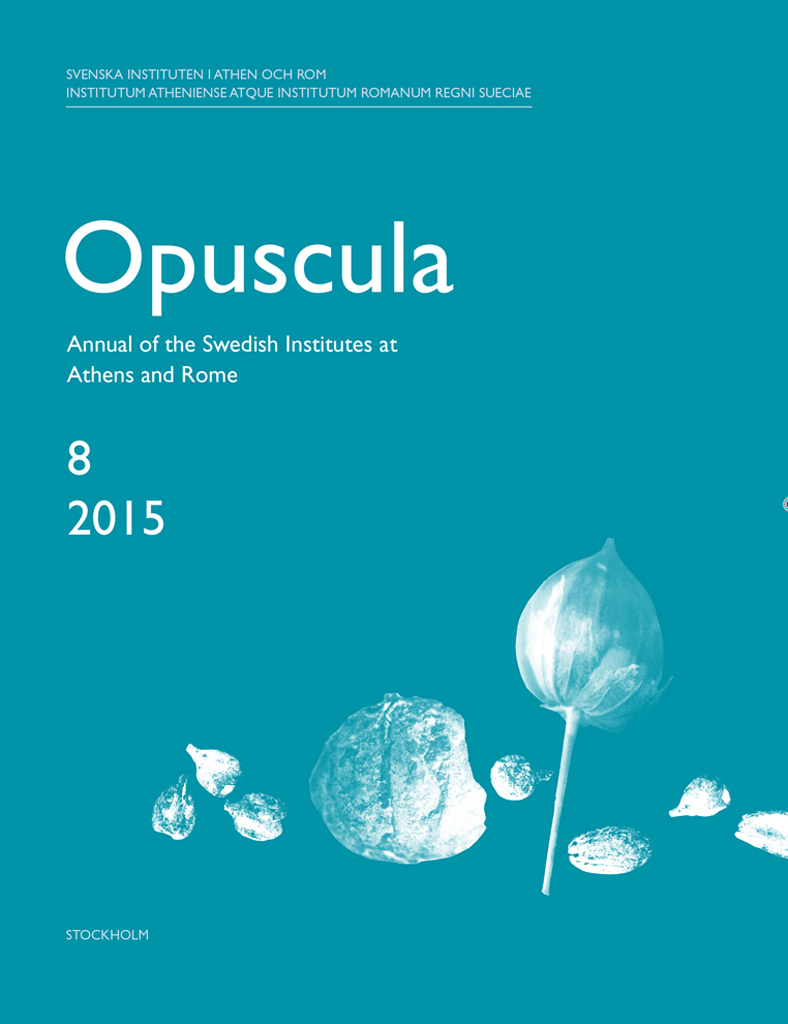Opuscula 8 (2015) is now available for purchase and free download at Bokorder.se. Also available at Amazon.com, Bokus.com and Adlibris.com. Two new Proto-White Painted ware vases of the pictorial style from Palaepaphos, Cyprus By Vassos Karageorghis & Efstathios Raptou Abstract The publication of two Proto-White Painted ware pictorial style vases found at the necropolis of Palaepaphos-Skales in Cyprus is preceded by a discussion of several issues relating to this style which appeared early in the 11th century BC. In recent years scholars have expressed conflicting views about the origin of the silhouetted pictorial motifs (birds, quadrupeds, human figures etc.), which appear next to the linear geometric decoration on such vases, usually amphorae and kraters. Some have expressed the view that the influence comes from Syria. Here it is proposed that the silhouetted figures of Proto-White Painted ware are derived from a Cypriote style with both local and Aegean characteristics, which developed in the 12th century BC. The pictorial motifs of this style, drawn both in outline and silhouette, are combined with linear geometric motifs, also in panels. In Proto-White Painted ware the pictorial motifs become rare and small. In order to be distinguished from the dominant linear geometric motifs they…
Opuscula 8 (2015) is now available for purchase and free download at Bokorder.se. Also available at Amazon.com, Bokus.com and Adlibris.com. The New Swedish Cyprus Expedition 2014. Excavations at Hala Sultan Tekke. Preliminary results. By Peter M. Fischer & Teresa Bürge. With contributions by B. Stolle, I. Trinks, L. Mazzotta, L. Recht, A. Lindqvist & D. Kofel. Abstract The initial aim of the project—the search for the oldest city of Hala Sultan Tekke—continued in 2014. Geophysical methods were used, which led to the discovery of new city quarters, and a broadening of the research objectives, to include revealing the total extent of the city. The GPR survey indicated a huge stone compound of at least 50 m × 40 m to the west of a probable street. Excavations continued in Area 6 West, where in 2013 a domestic and industrial compound was excavated as part of a hitherto unknown city quarter. The 2014 field work exposed stone-built structures and rich find contexts with locally made and imported pottery, numerous tools and several items of gold and silver jewellery. The violent destruction of the most recent layer of occupation, Stratum 1, which had been observed during previous seasons, was once again confirmed….
Opuscula 7 (2014) is now available for purchase and free download at Bokorder.se. Also available at Amazon.com, Amazon.de, Bokus.com and Adlibris.com. The New Swedish Cyprus Expedition 2013. Excavations at Hala Sultan Tekke. Preliminary results. By Peter M. Fischer & Teresa Bürge. With contributions by R. Árnadóttir, M. Mehofer, F. Köstelbauer, A. Satraki, L. Mazzotta, A. Trecarichi, D. Blattner, B. Stolle, & A. Miltiadous Johansson Abstract The results from a 1.3-hectare GPR survey in 2012 were confirmed during the 2013 excavation of a limited area (200 m2). Three phases of occupation were partly exposed. The most recent phase, Stratum 1, contained living and working facilities, e.g. for spinning, weaving and purple dyeing. Textile production also took place in the older Stratum 2, where the major activity was metal-working: 300 kg of remains from copperworking consist of tapped slag, furnace walls, fragments of at least five tuyères, crucible fragments, copper/bronze fragments and pieces of raw copper. Another of these unique kraters of White Painted Wheel-made Pictorial Style (WPPS) was found. It was termed “Horned God Krater” on account of one of the decorative elements. These kraters may indicate that there was a “Hala Sultan Tekke painter”. The oldest phase of occupation so…


